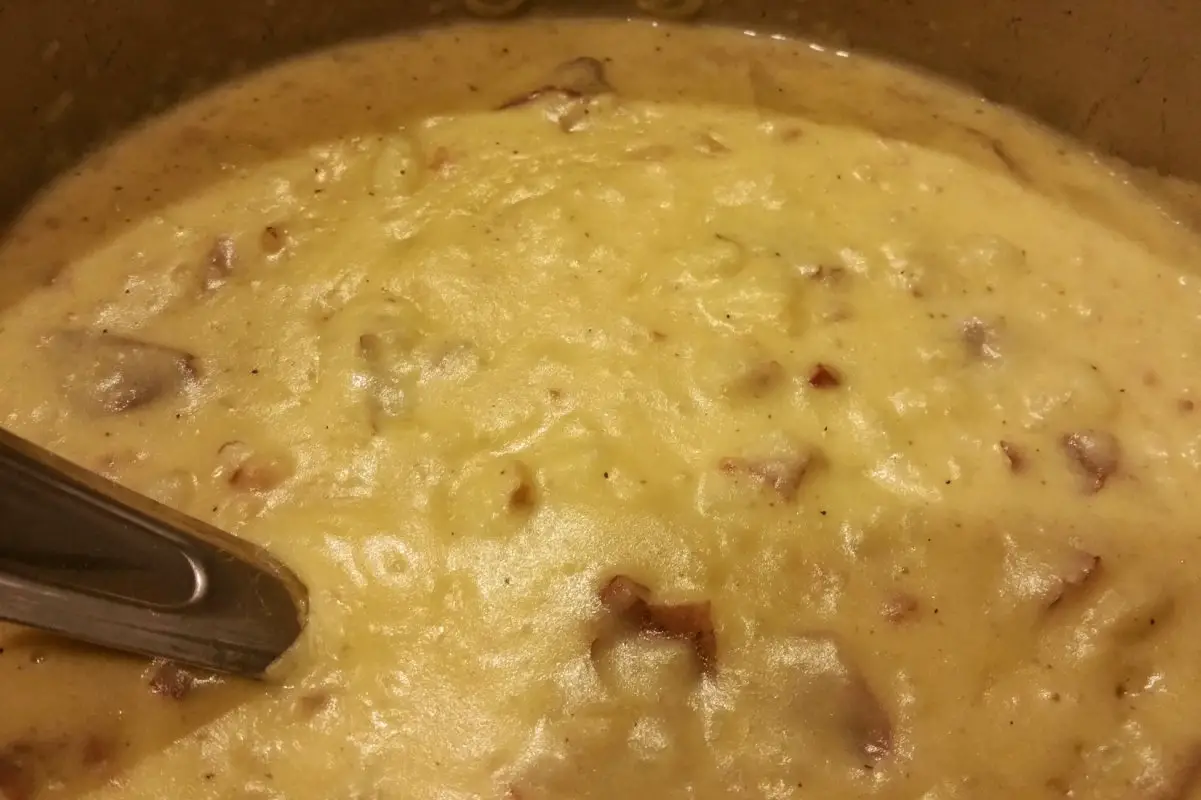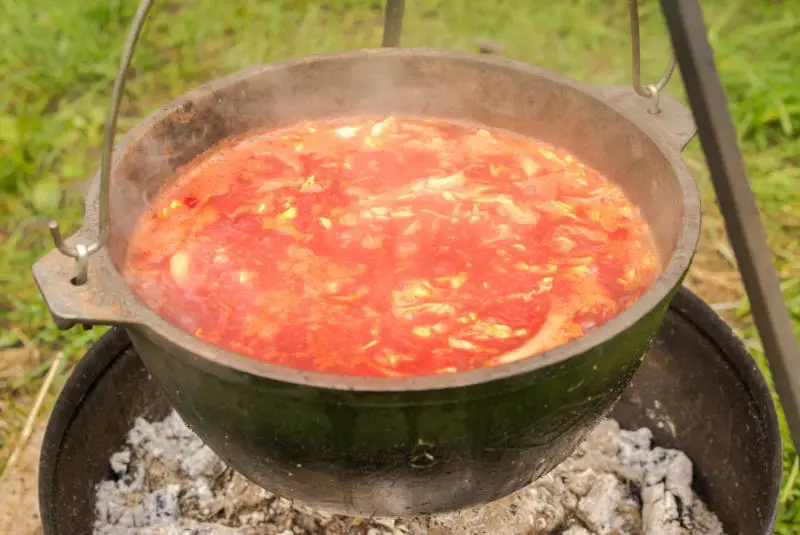
When people think of smoky flavors in food, they tend to think of grilled foods and smoked meats. However, it’s possible to add a smoke flavor to most dishes, including soups. That being said, if you add too much smoke, your meal will quickly move from tasting delicious to creating a too-strong, burnt sensation on your tongue, so is there a way to fix it?
If the smoke flavor in your soup is too strong, you can counteract it by playing with the recipe. Adding milk or cream will help mask the taste, as will adding potatoes to the dish. Other options include changing the pot you’re using to cook and adding ingredients with more intense flavors.
This article will look at how you can neutralize the taste if you go overboard and add too much smoke flavor or if you burn your pot of soup by leaving it too long on the stove. It will also look at how to add a smoky flavor to your soup, including using liquid smoke.
Note: most links in this article are Amazon.com Affiliate links, see Affiliate Disclosure, thank you.
How Do I Neutralise Smoky Flavor in My Soup?
While a subtle hint of smoke can add depth to your soups, too much smoke tends to be unpalatable to most people. The good news is, if you go overboard when adding smokiness to your soup, there are several methods you can try to counteract the flavor.
Change the Pot
Changing the pot is a good option if you suspect the smoky flavor results from the soup being burnt before being fully cooked. This happens a lot when using Dutch ovens or heavy bottom pots that have intense heat underneath.
It’s essential to stop stirring your food if you think you have a burned bottom and when you change pots, make sure to leave any residue in the original pot. This will ensure the burnt portion doesn’t add a smoky flavor to the soup while it’s being cooked.
Add Potatoes
If your recipe doesn’t already use potatoes, adding them can be a great way to counteract the flavor profile of smoke. This is because potatoes act as a sponge, absorbing both the excess smell and flavor of the smoke.
You don’t need to incorporate the potatoes into the final soup – just peel some raw potatoes, add them to the pan, and let them soak up the smoke. Keep tasting the soup, and once the flavor profile is where you like it, you can discard the potatoes and serve the soup.
Use Dairy
Milk is one of the best options to counteract the flavor of smoke in a dish. However, if you are serving soup, it’s unlikely that you’ll be using raw milk as part of your recipe.
Instead of milk, however, you can use other dairy products such as cream or cream cheese. This will make your soup much richer and will also ensure there is no smoky flavor present.
Play With the Ingredients
Depending on the recipe, there is a possibility you can add more ingredients to cover smoky or burnt flavors. You will need to use strong-tasting ingredients to do so, like vinegar, wine, or cider. These ingredients essentially serve to mask the smoky flavor, replacing its taste with its own. Some people also use curry powder or other spicy ingredients to the same effect.
Change the Aroma
Your sense of smell can play a strong role in determining the flavors people will taste in your soup. If no other alternative is working, try changing the aroma of your soup. If people cannot smell the smoke, they are less likely to taste it.
You can change the aroma of your soup by diluting it with other ingredients or reducing it down on the stove. Alternatively, you can also try serving it with other, stronger-smelling dishes or placing sweet-smelling flowers on your table before serving the dish.

How Can I Add Smoky Flavor to My Soup?
While too much smoke can pose an issue, a hint of smoky flavor can make your meals taste richer and more delicious.
When it comes to imparting smoke to a dish, many people think that the only option available to you is cooking with wood. While it’s possible to cook soup over an open fire, it’s not a technique you will use for everyday meals.
Instead of using wood to impart a smoky flavor to your soup, you can instead use several readily available ingredients. These include:
- Add smoked bacon or ham. Render the fat from the bacon and use it as part of your broth. Once the soup is complete, add the bacon to the soup to provide a subtly smoky flavor.
- Cook with a dark beer. Dark, smoky beers create a nice undertone for many soup recipes. We recommend using porters and stouts, as they have richer, more bold flavor profiles.
- Use lapsang souchong. This is a Chinese tea you can use to add a smoky flavor to vegetarian and vegan soups. First, brew the tea, then use it as part of your broth. Alternatively, grind the leaves and use the powder as a spice in your soup.
- Opt for smoked salt. Instead of using ordinary sea salt, try using smoked salt to finish your soup. Remember to only add the salt to individual portions of soup, however. If you use it for the entire pot, you risk over-salting to get the flavor of the smoke.
- Use smoked cheese: Nearly every variety of cheese is available in a smoked alternative. If you use cheese in your soups, opt for the smoked version of the cheese mentioned in your recipe.
- Use smoked spices. There are a number of spices available in smoked varieties, including smoked paprika. Other spices come with a naturally smoky flavor, like cumin and black cardamom.
What Is Liquid Smoke?
Aside from playing with the ingredients in your soup, you can also use liquid smoke in order to add a smoky flavor to your dish. This product is all-natural and is made by condensing the smoke that is a natural result of burning wood.
Once the smoke is condensed into a liquid form, it’s then concentrated, distilled, and filtered in order to make the flavor more pronounced. One advantage of liquid smoke over natural smoke is that the production process filters out impurities like ash, so you don’t have to worry about surprise flavors affecting the taste of your dish.
Additionally, by filtering out the impurities, the carcinogenic compounds present in wood-grilled food are also left behind. This means that liquid smoke is, in fact, a healthier option for imparting smoky flavor to food than wood grilling.
Some liquid smoke options, such as Stubbs Hickory Liquid Smoke, include other ingredients in their liquid smoke recipe, like salt, sugar, vinegar, molasses, and more. That said, it’s possible to find pure, liquid smoke – we recommend Lazy Kettle All-Natural Liquid Smoke.
Liquid smoke is available in many different wood ‘flavors,’ so you can choose the flavor profile that you like the best. It’s best to use only a small amount of the liquid when cooking, and you will usually only need to use half a teaspoon of it at most. It’s a great vegetarian (and occasionally vegan) alternative to adding a smoky flavor to your soups.
Conclusion
While a smoky flavor may be a delicacy for some people, it’s not for everyone. Even though you can counteract the flavor in your soup using one of the methods listed above, there’s no guarantee any of them will work. Thus, it’s essential that you keep an eye on how much flavoring you’re adding to the dish and keep it moving so nothing sticks and burns.
It’s better to add less flavoring and have to add more than find yourself scrambling to find a method to neutralize the taste before you serve.
